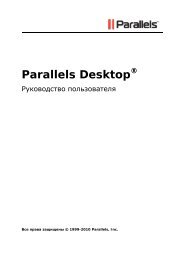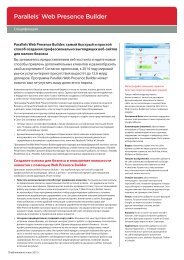[PDF] Parallels Server 5 Bare Metal
[PDF] Parallels Server 5 Bare Metal
[PDF] Parallels Server 5 Bare Metal
You also want an ePaper? Increase the reach of your titles
YUMPU automatically turns print PDFs into web optimized ePapers that Google loves.
Managing Virtual Machines and Containers<br />
1 Once you start the migration, <strong>Parallels</strong> <strong>Server</strong> <strong>Bare</strong> <strong>Metal</strong> checks whether the destination server<br />
meets all migration requirements and the virtual machine or Container can be migrated to this<br />
server.<br />
2 All virtual memory and disks of the virtual machine or Container are migrated to the destination<br />
server.<br />
3 The virtual machine or Container on the source server is suspended.<br />
4 The changed memory pages and virtual disk blocks, if any, are migrated to the destination<br />
server.<br />
5 The virtual machine or Container is resumed on the destination server.<br />
The virtual machine or Container continues running during steps 1 and 2 and is not available to the<br />
end user during steps 3-5. But since the amount of memory pages and virtual disk blocks changed<br />
during step 2 is small, the service outage time for the end user is almost imperceptible.<br />
Migrating virtual machines and Containers<br />
Depending on whether you are migrating a virtual machine or Container, the command-line options<br />
you pass to the pmigrate slightly differ. For example, you can migrate Container 101 from the<br />
local server to the destination server destserver.com by executing the following command on<br />
the local server:<br />
# pmigrate c 101 c --online destserver.com<br />
Enter password:<br />
Connection to destination server (192.168.1.57) is successfully established<br />
...<br />
Successfully completed<br />
At the same time, to migrate the MyVM virtual machine to the same destination server<br />
destserver.com, you can run this command on the local server:<br />
# pmigrate v MyVM v destserver.com<br />
Migrate the VM MyVM to test.com<br />
...<br />
The VM has been successfully migrated.<br />
As you can see, to migrate a virtual machine, you skip the --online option and use the v option<br />
to specify that you are migrating a virtual machine.<br />
Notes:<br />
1. For more information on options you can use with the pmigrate utility, see the <strong>Parallels</strong> <strong>Server</strong> 5 <strong>Bare</strong><br />
<strong>Metal</strong> Command-Line Reference Guide.<br />
2. After migration, the moved virtual machine may not be accessible over the network for several minutes<br />
due to latencies in the network equipment reconfiguration (for example, when switches need to update<br />
their dynamic VLAN membership tables).<br />
61


![[PDF] Parallels Server 5 Bare Metal](https://img.yumpu.com/18850617/61/500x640/pdf-parallels-server-5-bare-metal.jpg)
![[PDF] Parallels Desktop® 7](https://img.yumpu.com/18852044/1/190x245/pdf-parallels-desktopr-7.jpg?quality=85)

![[PDF] Parallels Python API Reference](https://img.yumpu.com/18850615/1/190x245/pdf-parallels-python-api-reference.jpg?quality=85)








![[PDF] Parallels Python API Reference](https://img.yumpu.com/18850529/1/190x245/pdf-parallels-python-api-reference.jpg?quality=85)

